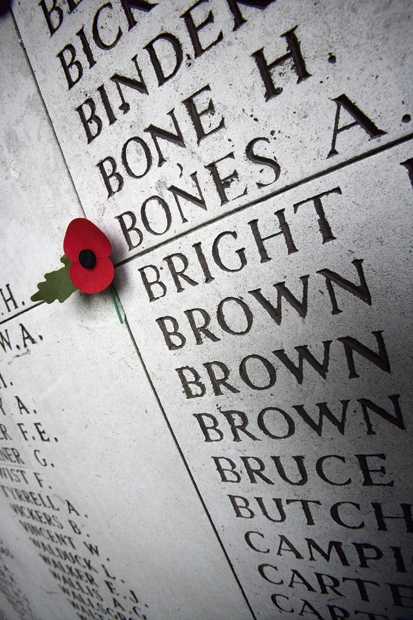We constantly need to be reminded that the consequence of war is death. In the case of the first world war it led to death and destruction on an inconceivably vast scale. To convey the enormity of what the industrialised slaughter that supposedly civilised governments unleashed between 1914 and 1918, film-makers like to pan the camera over a vast sea of white crosses. But if they do, that cemetery will probably be French or American. It will certainly not be British. The only cross in a cemetery maintained by the Commonwealth War Graves Commission will be a free-standing one with a bronze sword attached, a rather ‘Onwards Christian Soldiers’ symbol designed by Reginald Blomfield.
The graves themselves are marked by standard identical headstones, whether the body beneath (if identified) is that of an officer or private soldier, whether Anglican or Catholic, Jewish, Muslim or Hindu.
That the misused and squandered casualties of what certainly was a world war received such a dignified treatment in death was unprecedented (there are no cemeteries filled with the thousands who died at Waterloo) and, in the British empire, was largely the creation of one extraordinary man, Sir Fabian Ware. Appalled by the indifference of the military to what happened to soldiers after they were killed, Ware established the Graves Registration Unit within the Red Cross. In 1917 the Imperial War Graves Commission was founded which created the calm, elegant cemeteries which, as David Crane writes in this superb study, ‘along with the trenches — their mirror image and polar antithesis — are how most of us now see the first world war’.
What is not generally appreciated is how many cemeteries there are: almost 1,000 along the line of the Western Front in Belgium and France, some very small, all carefully landscaped and planted. And they are elsewhere: in the mountains of North Italy, in Macedonia and Greece, Palestine and, of course, at Gallipoli. Nor were the ‘missing’ forgotten — the half-million men whose bodies were never found or identified. Ware’s desire to honour every individual casualty held, for their names were carved on a series of Memorials to the Missing. And these are deeply impressive — and impressively non-triumphalist — structures, mostly classical in style, for the IWGC employed distinguished architects — Blomfield, Sir Herbert Baker, Charles Holden, Sir Robert Lorimer, Sir John Burnet — and one genius who was instinctively in tune with Ware’s vision, Sir Edwin Lutyens. It was a colossal achievent. Rudyard Kipling (the Commission’s literary advisor) called it ‘The biggest single bit of work since any of the pharaohs — and they only worked in their own country.’
The story of the foundation and achievements of the War Graves Commission has been told before, but never so well or so perceptively. Crane brings out the complexities of Ware’s character, which owed much to his Plymouth Brethren background. Before the war, he had been the editor of the right-wing, imperialist Morning Post, and I had not fully grasped before how much Ware’s vision, almost his religion, was imperial, something encouraged by his time in South Africa as part of Milner’s kindergarten, where he absorbed ideas about Britain’s global destiny and ‘race patriotism’.
Crane also brings out Ware’s brilliance as a diplomat, and his steely resolve, in successfully overcoming opposition to applying that vision to the treatment of the dead. For opposition there was: those, with the means to do it, who wanted to bring bodies home for private burial; those who wanted to raise their own headstones and monuments and those, in positions of authority — bishops, headmasters and the like — who wanted overt Christian symbolism in the British cemeteries. But Ware, like Lutyens, fully appreciated that men of all faiths (or none) had been flung into the conflict, and that all deserved equal honour.
The eirenic wisdom of Ware’s policy may be appreciated by visiting a French, German or American war cemetery, where lines of crosses are painfully interrupted by a Star of David or an Islamic arch-shaped stone. But Crane also brings out the paradoxes in Ware’s achievement: that his concern with individual casualties and democratic, non-sectarian equality of treatment required the assistance of the state that had been so cavalier with their lives; that ‘while the Commission served two masters, its first allegiance… was always to the Empire and not to the bereaved relative.’
It is also painful to read how Ware’s (and others’) sincere belief that the war cemeteries were an irresistible argument for peace made him a prominent appeaser in the 1930s: ‘If the history of war graves teaches one lesson it is that while the “tongues of the dead” might say what they must, the living will hear what they want.’
David Crane writes that
The man who made it possible for a country to come to terms with the unbearable debt it owed its dead is scarcely better known now than those whose graves only bear the inscription ‘Known unto God’.
This is not quite true. Stephen Wyatt’s radio play about Fabian Ware: Memorials to the Missing was broadcast by the BBC in 2007 and won awards. And next year an English Heritage blue plaque will be unveiled on his London home.






Comments